Honor Award
Multi-Variate Study of Stormwater BMPs
BNIM, Kansas City, MO
Client: U. S. Green Building Council
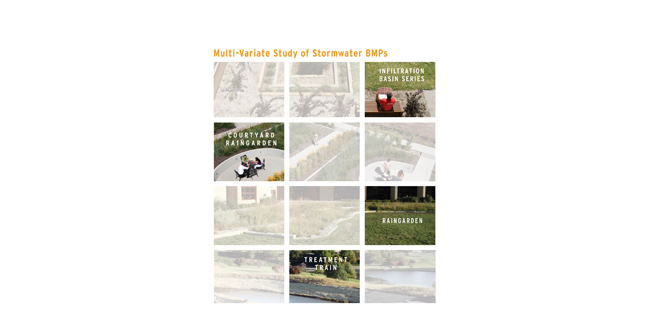
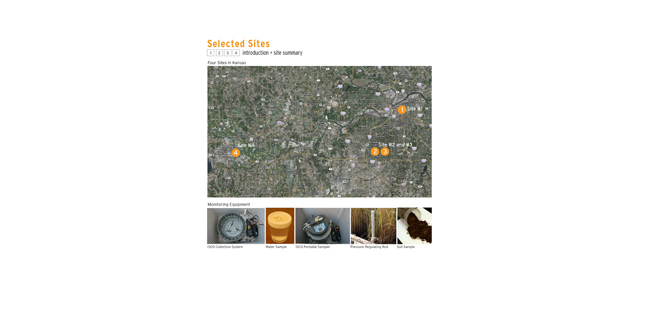
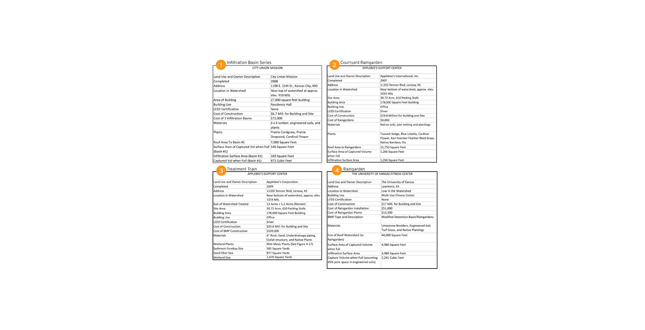
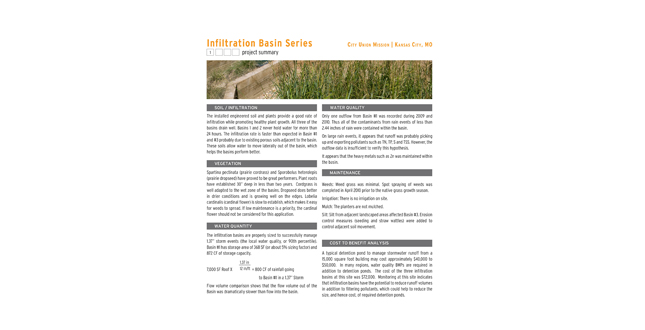
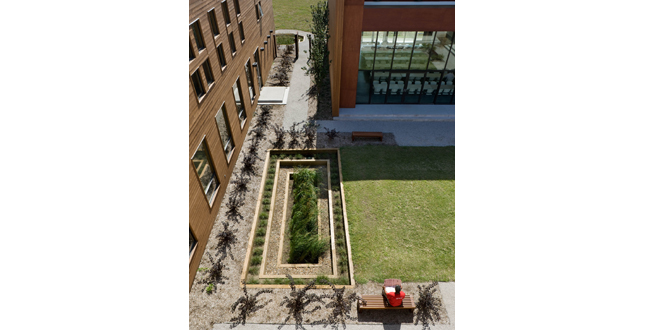
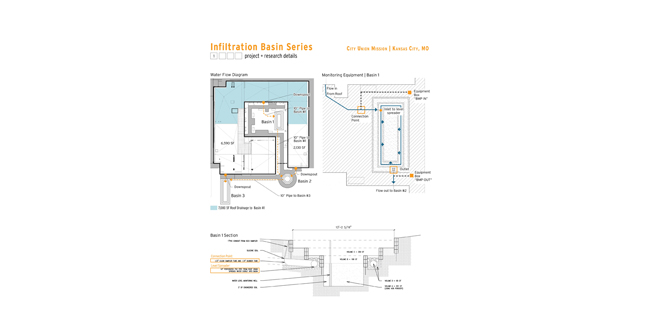 Close Me!
Close Me!Infiltration Basin Series. Project + Research Details
Download Hi-Res ImageImage: BNIM
Image 6 of 15
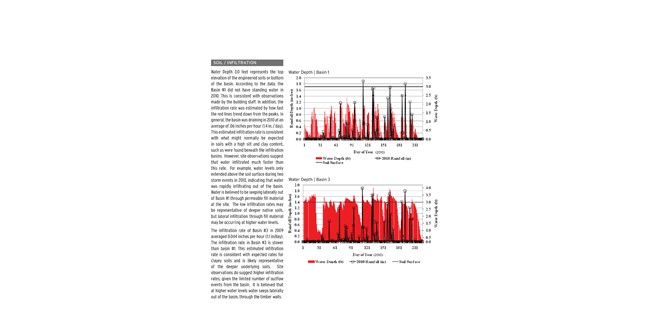 Close Me!
Close Me!Infiltration Basin Series. Project + Research Details
Download Hi-Res ImageImage: BNIM
Image 7 of 15
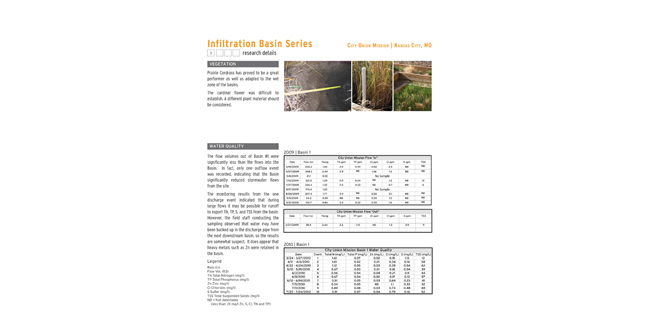

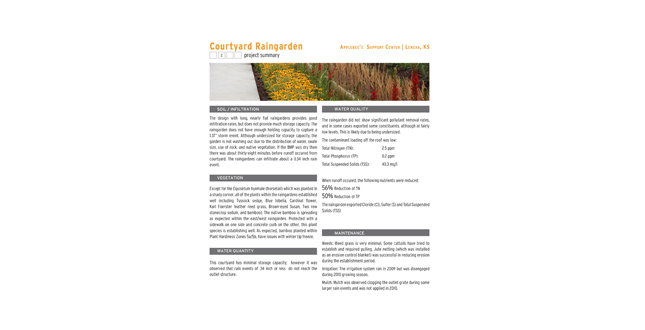
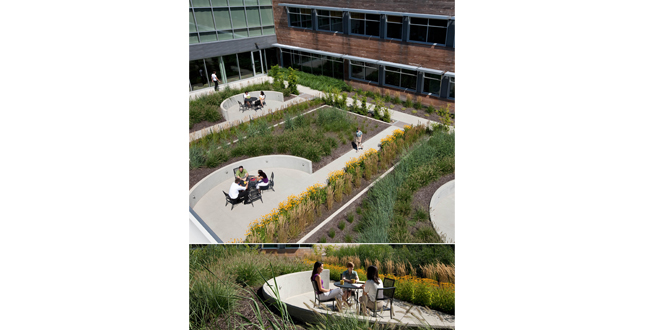
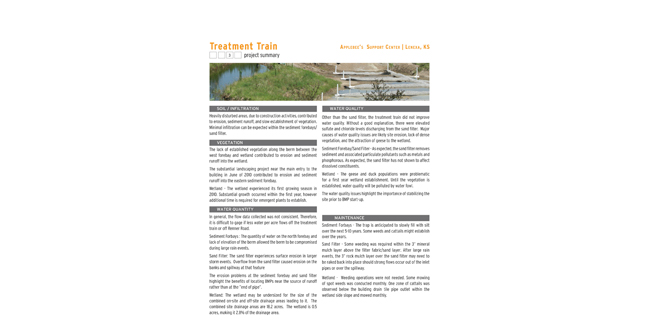
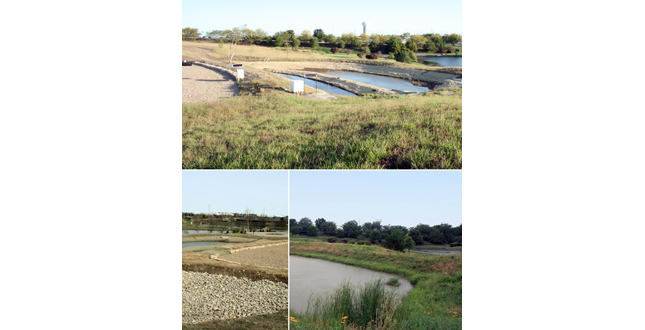
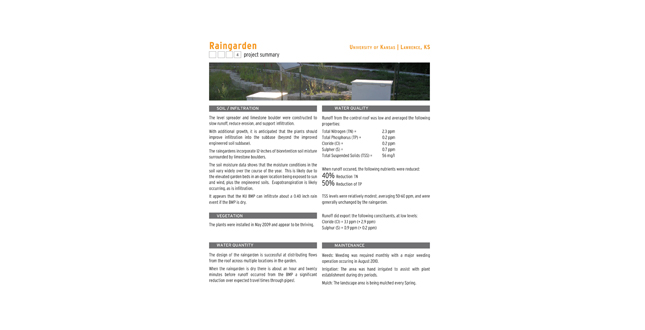
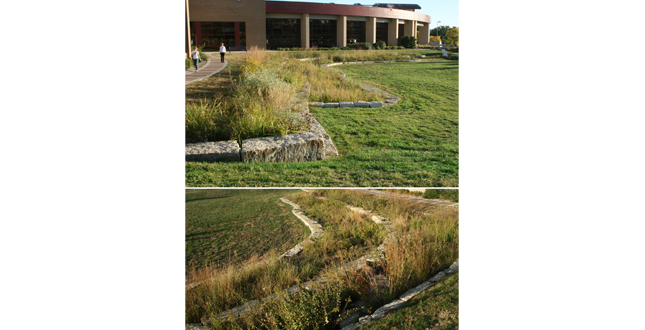
Project Statement
Information on how well Best Management Practices (BMPs) perform is critical to quantifying their benefits. Sponsored by the U.S. Green Building Council, the research team completed two years of monitoring and analyzing the success of rain gardens, infiltration basins, and treatment trains in the Kansas City Metropolitan area. Research conclusions include the analysis of BMP performance, the evaluation of vegetation and soil composition, and recommended design modifications. The team’s research advances sustainable building practices and encourages market transformations.
Project Narrative
—2011 Professional Awards Jury
Completed in February 2011, the team’s research of BMP performance examines rain gardens, infiltration basins, and treatment trains in the Kansas City Metropolitan area. Monitoring equipment measures rainfall quantity and intensity, as well as runoff quality and flow rates. Each type of monitoring equipment provides stand alone data, but when combined together depicts the larger story.
Research Grant Program
The U.S. Green Building Council (USGBC) created the grant program to spur research that will advance sustainable building practices and encourage market transformation. The research team was one of 13 recipients out of over 250 applications for the 2008 Green Building Research Fund Grants, the first grants of their kind in the green building industry. This research topic was Priority Topic No. 2 under the category of Ecosystem and Site Design and focuses on managing stormwater around sustainable building sites.
Purpose of Research
Completed in February 2011, the research team examined the performance of Best Management Practices (BMPs) including rain gardens, infiltration basins, and treatment trains in the Kansas City Metropolitan area. BMPs are systems used to capture stormwater runoff near the point of generation (e.g. roofs, patios, parking lots, driveways), slow runoff rates, infiltrate stormwater into site soils, and remove pollutants, while also creating landscaping amenities and habitat enhancements. BMPs are used to integrate stormwater management into site landscaping amenities.
This topic affects many fields—architecture, construction, facility maintenance, engineering and, most importantly, human behavior and health. Lessons and information gathered from this report have the capacity to alter design standards, and policymaking and to significantly impact human health and productivity. This document includes thoughts related to the potential to influence building and site design as well as development policy and standards, facility operations and maintenance standards. This research yields results that can address such business and City Department concerns as dollars lost in stormwater management. Additional outcomes include reducing aquifer depletions, becoming good stewards to downstream neighbors, and abating flooding. All of these factors create better, more livable communities and neighborhoods.
Only 3% of the water in the world is fresh water (with a majority of that water held in glaciers and polar ice caps). It has been estimated that less than 1% of fresh water is available for use and consumption with no more water being produced. With increasing demand from growing populations, fresh water will become a valuable commodity (probably more so than oil). Many cities across the nation have embraced and experienced success with green solutions. BMPs should be incorporated into all facets of building, construction, design, and policy to protect water as a precious resource.
Research Topic Goal
Develop or improve Best Management Practices (BMPs) for on-site stormwater management, including effective utilization, treatment, infiltration, and storage.
Objectives
(Not all objectives were evaluated at each site.)
Promote the use of alternative on-site sources of water.
- Outreach: Raise awareness regionally of what is possible, what is probable, what is provable, and replicable.
- Maintenance: Determine to what level maintenance standards affect the success of the systems. Explore whether sustainable design features such as soils, vegetation and layout affect the performance of the system. Identify any major issues identified that can reduce the effectiveness of the BMP, including siltation, weed growth, and irrigation usage.
Provide a process that is replicable in different climates / bio-regions.
- Availability: Use the International Stormwater BMP database with its described protocol for stormwater monitoring. Document the findings using the database forms so that the data can be shared globally.
- Design Modifications: Identify improvements to BMP design components (per different climates/bio-regions).
Documentation
- Water Quality: Document the success of removing pollutants from surface runoff from building roof and impervious surfaces with the integration of BMPs. The focus will be on the start of rain events when pollutant loading is at its highest (first flush rain events).
- Soil Infiltration Rates: Document the infiltration rate of the BMP as a measure of reducing runoff and recharge of the aquifer.
- Soil Sampling: Document the change in soil over time and within the BMP. Explore whether sustainable design features such as soils, vegetation and layout affect the performance of the system.
- Facility Sizing: Evaluate the performance of the BMP in comparison to its size verses the drainage area.
- Performance Baseline: Compare results to preliminary hypothesis, BMP database, or previous submitted LEED Certification documentation.
- Cost: Address how BMPs can be created effectively on sites with smaller budgets but still be effective with limited budgets.
USGBC LEED Impact
- Rating System: Evaluate the success or shortcomings of the current LEED credits involving stormwater management.
Equipment
To meet the project goals and objectives, the research team installed a variety of monitoring equipment at different sites. Each type of monitoring equipment provides stand alone data, but when combined together depicts the larger story. Onset Data Logging Rain Gauge measured actual precipitation and rainfall intensity at each site as well as when rain events started. Teledyne ISCO Portable Samplers with Bubbler Flow Module attached collected water samples and flow data at 30 minute intervals. The research team was able to collect water samples at the start of a rain event and as a composite throughout the entire rain event. Soil sampling was done to test particle size distribution, pH, Zinc, bulk density, infiltration rate and organic matter content of the planting soil within the BMPs. Piezometers (small diameter wells) were installed at the City Union Mission site to help measure how well the Infiltration basins function during storm events, infiltrate water into the surrounding subsoil, and recover capacity between storm events.
Site Selection
The research and technical team discussed this grant as having a unique niche to fill. The audience for this monitoring project includes architects, landscape architects, engineers, and property owners. The importance of retrofit BMPs was deemed important to site selection. In addition, there was an opportunity to respond to the financial side of BMPs. Less expensive BMPs were chosen to show that cost does not need to be a major factor when designing BMPs while still accomplishing great quantity and quality results (cost to benefit ratio). The selected sites were:
- Site #1: City Union Mission, Infiltration Basin
- Site #2: Applebee’s Support Center, Raingardens
- Site #3: Applebee’s Support Center, BMP Treatment Train
- Site #4: The University of Kansas Fitness Center, Modified Detention Basin/Raingarden
Findings
Findings were documented at the start of each chapter for each site and BMP investigated. Below are just a few of the overall conclusion from the research (found in Chapter 6 "Conclusions:"
- Preserve the existing landscape. The less site disturbance the better. It is easier to maintain the existing landscape than to rebuild it.
- Site development significantly disturbs site soils. Minimize site disturbance to the maximum extent possible. Greater effort also needs to be placed on restoring soil structure and organic matter before sites are vegetated, in order to help establish healthy, dense vegetation, limit weeds and erosion, and reduce the need for herbicide applications. This can be done through deep tilling/ripping, plus addition of organic matter in the form of compost, a sustainable, recycled product. This will also improve soil moisture retention for plant health, promote healthy root growth in plants, and promote stormwater infiltration across the site.
- Keep designs simple, especially in areas where BMPs are new techniques and have not been widely constructed or maintained yet. Simple designs can still be attractive and elegant. Complex designs are more difficult to build and likely will not get fully maintained.
- BMPs are most effective when they are located near the source of stormwater runoff and treat small drainage areas (less than one acre). That approach more closely replicates ecological form and function of the natural landscape and replicates hydrology of the natural landscape. End of pipe systems are more susceptible to erosion and bypass in large storm events and are less effective in replicating the hydrology and function of the natural environment. This is part of the philosophy of Low Impact Development (LID) and it is totally applicable to sustainable site design approaches as well.
- Size matters. Undersized systems will have problems. BMP design guidelines in many parts of the country recommend that BMPs be designed to capture the "Water Quality Storm Event" which is often the 90th percentile storm event. That means, over the long-term average, 90 percent of storm events are that size or smaller. At the same time, conveyance features in, out, and around BMPs need to be sized to safely pass larger storm events without damage or erosion.
- Design objectives will be different at every site, and the BMP designs can be customized to the site-specific objectives. At some sites water quantity control (runoff volumes and rates) may be more important than water quality control. In those cases, infiltration BMPs would be preferred.
- BMP designs can be customized to promote removal of specific types of pollutants. Some pollutants exist in particulate forms, others in dissolved forms. Pollutant removal mechanisms vary with the type of pollutant, and include sedimentation, precipitation, filtration, adsorption, biodegradation, and photodegradation. Depending on the pollutant of most concern, certain removal mechanisms can be enhanced by the design.
- Site characterization is a critical part of the design effort. Soil types and compaction, the presence of fill material, depth to bedrock and groundwater, and the presence of subsurface utilities should all be taken into account in the BMP design process.
- Plant selection is very important.
- BMPs don’t have to be expensive to be effective. Low cost and locally available native materials can be used to create attractive and functional designs.
Applicability to landscape architecture practice
Very little research is being done by landscape architects on BMP successes and failures. We typically dependent upon the environmental engineering practice to document findings. This research focuses on urban applications expanding the traditional practice of landscape architecture.
Future Research
Since this research investigated project recently completed, it would be valuable to hook up the equipment after about 5 years to compare root penetration, soil composition, infiltration rates, and contaminant removal to gauge the long term success of the BMPs.
Project Resources
BNIM
Lead Designer / Principal Investigator: Jim Schuessler, ASLA
Mark O’Hara, ASLA; Celine Armstrong, ASLA; Christina Hoxie
Civil Engineer
Phil Barnes, KSU Biological and Agricultural Engineering
Environmental Engineer
David Dods, , URS
USGBC
President, CEO and Founding Chair: Rick Fedrizzi, Honorary ASLA;
Education Relations: Sean McMahon;
Director of Research Programs: Tom Dietsche
Landscape Architect
Tim Keane, , KSU College of Architecture, Planning and Design
Architecture Student
Jesse Benedick, Kansas State Landscape






